BASE UK Members Study trip to France, 3rd to 6th December 2019
Posted January, 14th, 2020
Michael Scantlebury joined BASE-UK in June 2019 and having gone on his first Member’s trip to France has written the following summary.
21 members from across the UK made the trip over or under the Channel to visit two farmers practicing conservation agriculture to the north and south of Paris. Having travelled largely separately or in twos and threes on the Tuesday we all met up on Wednesday morning at Frederic Remy’s farm on the estate Saint Lubin which is used for wild boar and pheasant shooting as well as having a productive arable farm. We met at his machine shed where we had the opportunity to see his drills, a 6m Horsch CO fitted with Metcalf points and a 6m Horsch Avatar. He explained having both a tine drill and a disc drill gave him flexibility according to crop residues present and soil moisture.
We went out to his fields where we first saw his OSR which was companion cropped with beans(65kg/ha), white clover(2.5kg/ha) and buckwheat(5kg/ha). He also put 1.5kg/ha ferric phosphate slug pellets down the drill as well. The crop looked well with the beans much in evidence and twice the height of the rape. A rape plant that was pulled up had a central root extending an impressive 500mm deep.
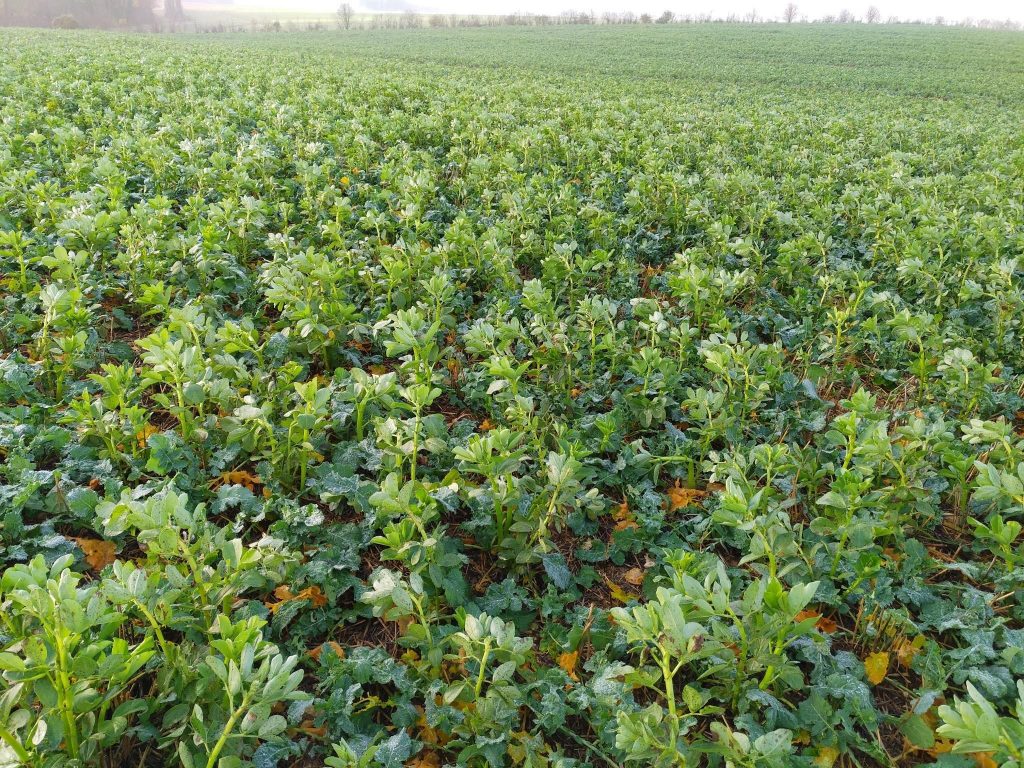 }
}
Nearby Frederic had a demonstration/test Horsch crop crimper roller working destroying cover crop made up of vetch, clover beans and black oats. To my mind two passes were doing a reasonable job although I didn’t think the rear harrow was useful, it seemed to move a surprising amount of soil and caused bunching of the loose cover crop residue. However with doubts about the future Glyphosate rumbling on this is an area we need to keep looking into. Added excitement came with the emergence of about 15 wild boar from the cover crop which the tractor driver then chased off the field with the crimper into the surrounding woodland before returning to work.
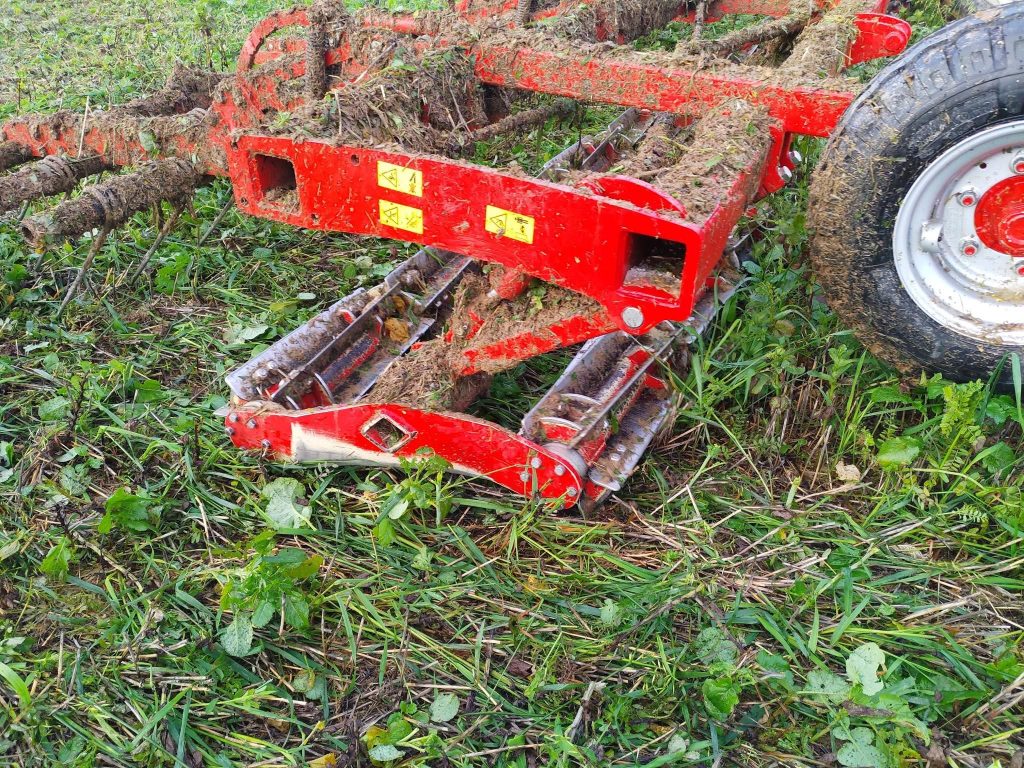 }
}
We finally looked at a wheat crop established after rape which looked well despite “enjoying” a similarly wet autumn to what we have experienced here in the UK this year. We left the fields and went for lunch at a restaurant in a local town which was most enjoyable. After lunch we headed off south to hotels in either Blois or Beaugency close to the river Loire.
The following morning we met back up at Frederic Thomas’ farm near Dhuizon where he has been practicing regenerative agriculture since 1996. His soil is made up of clay and sand with no silt content and so has no natural structure; in its natural state it suffers from waterlogging in winter. We started by looking at a field that had been under his system of management for over 20 years and despite the wet autumn the wheat after maize looked well and the soil was friable and structured.
 }
}
We looked at a number of fields Frederic managed for neighbours as well as his own which showed that the longer his system of management had been used the better the condition of the soil with a brown colour developing to a greater and greater depth. The biggest contrast to his long term managed soil was a neighbour’s field which was min-tilled and drilled: the soil was grey, waterlogged and structureless. The wheat crop looked like it would ultimately be a failure.
Frederic showed us that he was introducing sheep to the farm to graze cover crops, like a lot of his farming this was done through cooperation with none of the sheep being his own. The flocks were small and moved daily to minimise poaching. He thought that the process of converting land to regenerative agriculture could be accelerated by planting relay cover crops for grazing. He was receiving 14 cents per head per day for the sheep grazing.
Frederic’s spirit of cooperation extended to most of his farming in part because he lives and works a three and a half hour drive away. He worked with two other farmers who provided most of the labour although he provided much of the machinery, most of which wasn’t that new and shiny with the exception of a 3m Sky EasyDrill. The three of them had fixed prices for each operation with fixed hire charges for each tractor and machine and an hourly labour rate. He felt that farmers should be working together more to match their skills and machinery.
 }
}
The neighbours cultivated wheat field!
Frederic had quite a flexible approach to his cover crops. After maize he used a mix of vetch, beans, barley and winter peas established using a front mounted pneumatic broadcaster with a Duro star cultivator on the back of the tractor which he felt was acceptable amount of cultivation because of the large amount of residue left by the grain maize. Later in the day we saw this setup working on one of the partner farms putting in winter barley within sight of the Loire river.
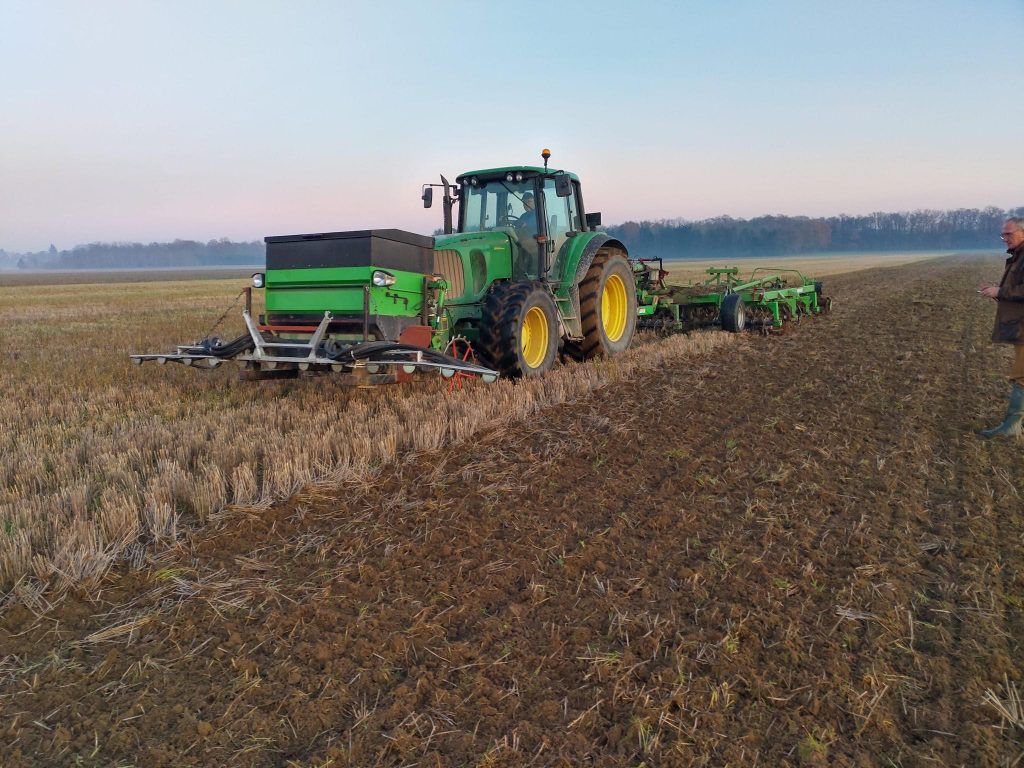 }
}
Frederic’s flexible approach also lead to him telling us that a cover crop can become the crop, for example he had a cover crop of triticale and beans and he thought he may keep one or the other or even both to harvest. In another plot he was growing vetch, beans, peas and radish together and was going to harvest them together to produce cover crop seed for next year. Because of his southerly latitude Frederic has much hotter and drier summer weather than the UK. In some years he was able to combine the buckwheat companion crop in his newly sown oilseed rape crop in the early autumn. Another piece of cropping wisdom he had was that sometimes you have to choose crops that aren’t profitable in their own right to make the rotation/system profitable.
As an exponent of regenerative agriculture and the potential to reduce chemical inputs he was interested in the political side of agriculture and thought that the Swiss model of paying for non-use of chemicals had much merit. An oilseed rape crop grown without any spray chemicals attracted a payment in Switzerland of 120 Francs per hectare. He was of the opinion that politicians may be persuaded of the value of maintaining an approval for Glyphosate in a conservation agriculture situation. When it came to lobbying politicians he thought going to visit them in their seats of power was a waste of time and we should be getting politicians on farm to show the benefits of conservation agriculture to them.
Frederic’s reputation had lead to him being involved in the reintroduction of market gardening at the Chateau de Chambord using conservation agriculture techniques. The plan is to provide produce for the cafe at the Chateau that had a million visitors a year with an estimated further million who visited the grounds each year.
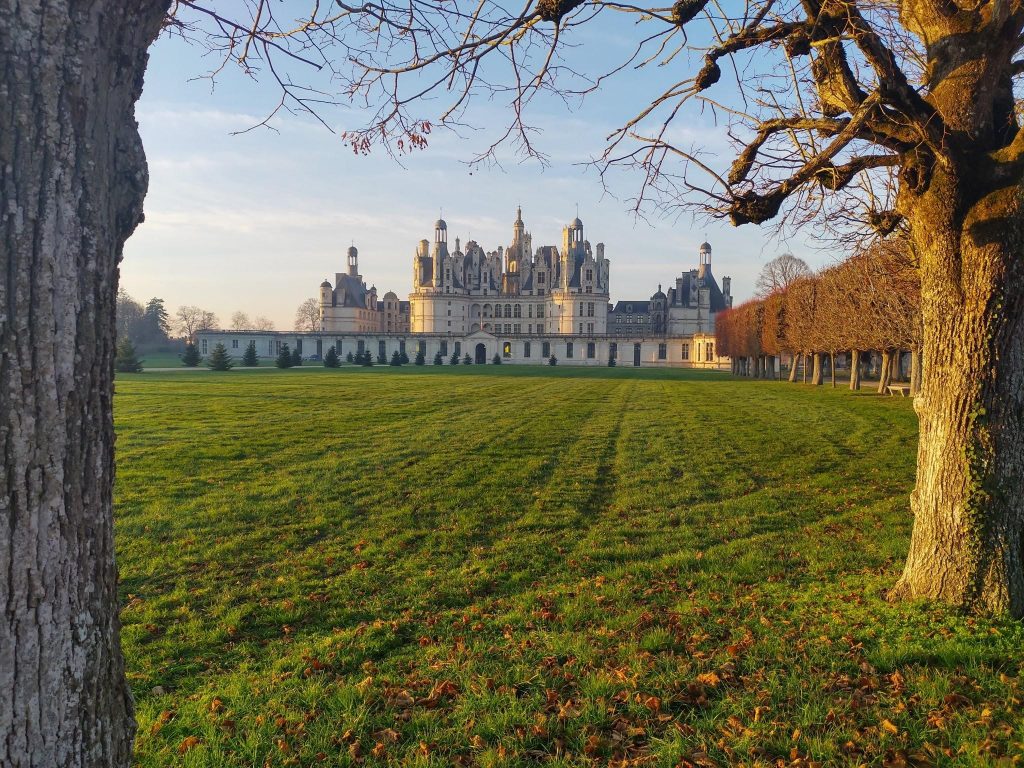 }
}
One of Frederic’s partners was involved in reintroducing the local sheep breed to the Chateau grounds. These were kept in the traditional extensive way rather than the mob grazing method we had seen earlier in the day.
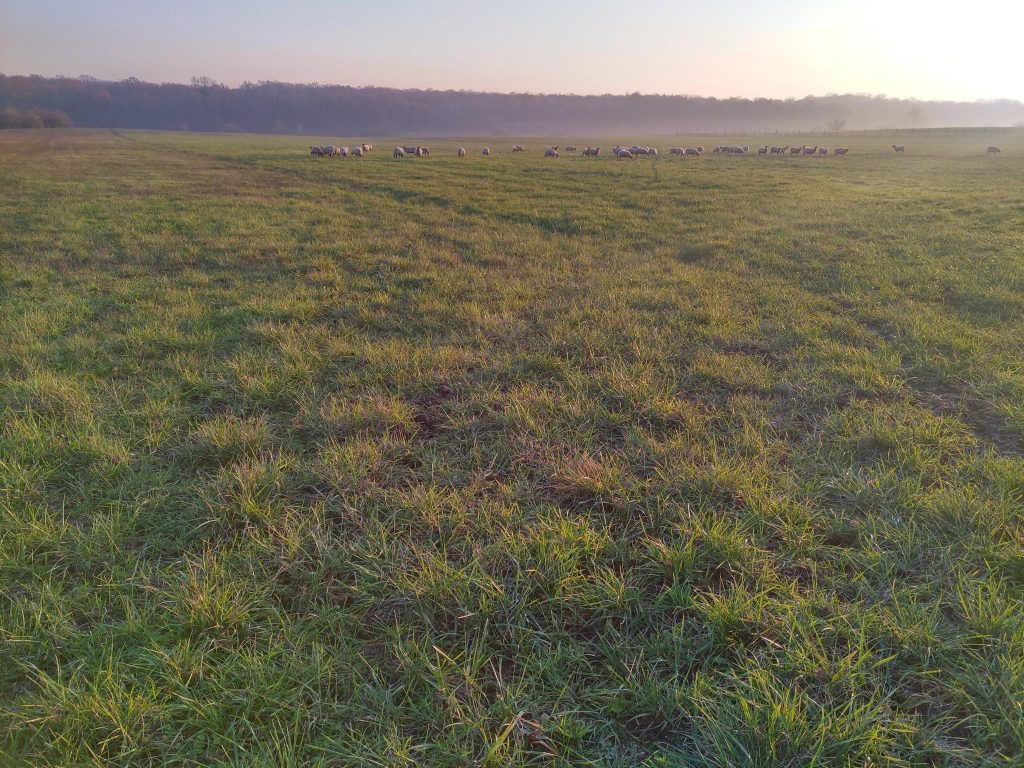 }
}
Our final visit of the day was to a vineyard for a tour of the winery and wine tasting.
My own take home messages are:
To make more use of crops that grow well locally as cover crops, in my case particularly beans.
The best cover crop mixes are based around legumes.
Be more flexible and pragmatic about both cash crops and cover crops in terms of both what is grown and how they are established.
The process of building resilience and sustainability with conservation agriculture takes time (I am only in year two) but could be hastened by the introduction of grazing livestock.
Think about how you might work more with other farmers, Frederic Thomas’ advice was to buy a different drill to your neighbours that might give more flexibility to both of you?
We need to work harder at getting our political masters on farm to show them the good we do rather than just telling them; this point probably applies to all farmers.
Humphrey Mills, a fellow BASE-UK Member and traveller comments:
It was a surprise to see the wild boar foraging in the cover crops and also to realise the damage they are causing to agriculture and the cost of controlling them throughout France.
Seeing Frederic's effect on soils from 20 years + to only in its first or second year under his style of management, made a strong impression. One of the most dramatic differences was the pale worm casts in the new field compared to the field next door where they were black. It was a good illustration of what a long term job this is but how the benefits are cumulative and worthwhile.
It is clear that Frederic is continually thinking about new and different ways of farming as demonstrated by his star wheel seeder and the introduction of sheep into his rotation. It is a classically beautiful part of France.
We were also struck by the industrial sized fields and fantastic looking soils on the way back to the tunnel. Personally, I would feel rather daunted at the prospect of competing with all the spring and winter barley that seems to be getting established this year over there as well as in the UK.
More photos are available courtesy of David White - on https://photos.app.goo.gl/w67oX5sz2tYQdePc6
Our thanks go to everyone in France who hosted and made this trip a successful, educational visit - especially to Frederic Thomas and Frederic Remy. We look forward to further visits in the future.
Recent Posts
BASE-UK - ANNUAL CONFERENCE 2024 - SIX INCHES OF SOIL PREVIEW
BASE-UK - ANNUAL CONFERENCE 2024 DAY 2 - HANNAH FRASER
BASE-UK - ANNUAL CONFERENCE 2024 DAY 2 - RICHARD JENNER
BASE-UK - ANNUAL CONFERENCE 2024 DAY 2 - DAVID GOODWIN
BASE-UK - ANNUAL CONFERENCE - DAY 2 - JAY FUHRER PART 2
BASE-UK - ANNUAL CONFERENCE DAY 2 - JAY FUHRER PART 1
BASE-UK - ANNUAL CONFERENCE DAY 1 - SPEAKER PANEL
BASE-UK - ANNUAL CONFERENCE DAY 1 - BEN ADAMS
BASE-UK - ANNUAL CONFERENCE DAY 1 - TOBY SIMPSON
BASE-UK - ANNUAL CONFERENCE DAY 1 - ALEX FRASER
